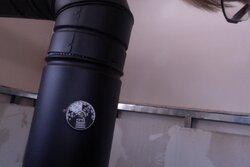I'm getting used to a Drolet Eldorado EPA, non-cat stove. About 3 days of ~14hr long fires so far. Burning dry oak, split into 3-5" diameter pieces.
Double-wall stovepipe is about 3' vertical, then 3' horizontal to the Selkirk double-wall chimney.
So far, I haven't seen a stovepipe temperature above ~450F, and typical stovepipe temperature is about 300F. Measurement is taken with an SBI thermometer, which is a probe-type that sticks into the middle of the stovepipe. I installed the thermometer about 24" above the stove, and the above-stove damper has only ever been wide open.
So, is this an ok stovepipe temperature? Is there something else I should be doing (or burning) to get the temp higher?

Double-wall stovepipe is about 3' vertical, then 3' horizontal to the Selkirk double-wall chimney.
So far, I haven't seen a stovepipe temperature above ~450F, and typical stovepipe temperature is about 300F. Measurement is taken with an SBI thermometer, which is a probe-type that sticks into the middle of the stovepipe. I installed the thermometer about 24" above the stove, and the above-stove damper has only ever been wide open.
So, is this an ok stovepipe temperature? Is there something else I should be doing (or burning) to get the temp higher?

Last edited by a moderator:


